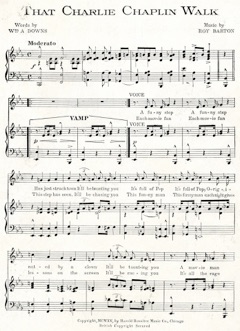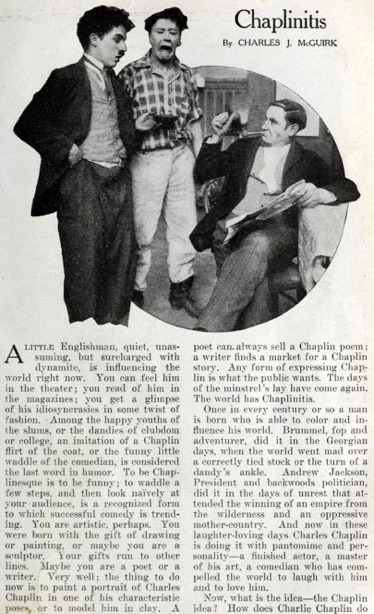A Woman Clippings 16/72
Charles J. McGuirk, Motion Picture, New York, July 1915.
The New Fox Trot Song
Charlie Chaplin Walk
Words by Wm. A. Downs
Music by Roy Barton
Essanay
Harold Rossiter Music Company Chicago-New York
1915, Margaret Herrick Library,
Academy of Motion Picture Arts and Sciences, Part 2
„Once in every century or so“
Editorial content. „Chaplinitis
By Charles J. McGuirk
A little Englishman, quiet, unassuming, but surcharged
with dynamite, is influencing the world right now. You can
feel him in the theater; you read of him in the magazines; you
get a glimpse of his idiosyncrasies in some twist of
fashion. Among the happy youths of the slums, or the dandies
of clubdom or college, an imitation of a Chaplin flirt of the
coat, or the funny little waddle of the comedian, is considered
the last word in humor. To be Chaplinesque is to be
funny; to waddle a few steps, and then look naively at your
audience, is a recognized form to which successfull
comedy is trending. You are artistic, perhaps. You were born
with the gift of drawing or painting, or maybe you are
a sculptor. Your gifts run to other lines. Maybe you are a poet
or a writer. Very well; the thing to do now is to paint
a portrait of Charles Chaplin in one of his characteristic poses,
or to model him in clay. A poet can always sell
a Chaplin poem; a writer finds a market for a Chaplin story.
Any form of expressing Chaplin is what the public
wants. The days of the minstrel‘s lay have come again.
The world has Chaplinitis.
Once in every century or so a man is born
who is able to color and influence his world. Brummel, fop and adventurer, did it in the Georgian days, when the world
went mad over a correctly tied stock or the turn of a dandy‘s
ankle. Andrew Jackson, President and backwoods
politician, did it in the days of unrest that attended the winning
of an empire from the wilderness and an oppressive
mother-country. And now in these laughter-loving days
Charles Chaplin is doing it with pantomime and
personality – a finished actor, a master of his art, a comedian
who has compelled the world to laugh with him
and to love him.
Now, what is the idea – the Chaplin idea? How does
Charlie Chaplin do it? Is it the man, or is it his work,
or is his personality the embodiment of a world-thought?
Does a war-sick universe turn from the horrors of
wholesale slaughter to the rib-tickling situation of a man
hit on the head by a mallet in the hands of this
gentle little Englishman who never smiles and who looks
out on the world with the naive wonder of a little
child? Let‘s try to find out why you snicker?
There is a lame beginning in my statement that Charlie
Chaplin cant explain his own humor. He has tried
a couple of times, and he has said some very interesting
things. He confesses that his humor depends almost
wholly on contrast and timeliness. It does, to a certain extent.
But you or I could go thru the same actions, use the
same gestures and wade thru the same situations as he does.
Would we bring the laughter that Charlie Chaplin does?
I rather think not. Laugh-getting is Charlie‘s monopolistic gift.
He was born to laughter as much as Edison was born
to invention and Tolstoi was born to world literature. He cant
explain his methods – genius has no prompt-book.
Chaplin is bubbling over with fun, and it has to slop over.
It is as inevitable as the budding leaf or the downhill
rush of water to the sea.
When you see Chaplin, you laugh. When you know
him, or when you see him making his own pictures,
you have a glimmering idea of why you laugh at him and his
antics. But for the life of you, you cant analyze the
reason for your laughter and for Chaplin‘s success in comedy.
The fact of the matter is that there is some unlocated
spot in you which Chaplin touches and which responds to that
appeal by making you laugh. That is the best explanation
you can get, even tho you go to Johns Hopkins and get the
results of a professional laugh-dissector‘s researches.
Chaplin draws laughter out of you as the sun draws water from
the sea. It is a matter of attraction, and that‘s all there
is to it. So much for philosophy.
When Chaplin first came to the Essanay studio, he almost
stopped the works. Every person in the studio – actors,
and actresses, property men, scenario writers, the publicity
department and even the business office – side-stepped
their tasks and stole down to the studio floor to watch the genius
apply his methods. Even then he was comparatively
unknown. The world had just begun to recognize that the
funny little man with original methods could make
whole audiences hold their abdominal muscles and go home
sore from uncontrolled laughter.
But the wiseacres in Moving Pictures knew Chaplin
and knew his possibilities. Hence the interest
that manifested itself in the Essanay studio and the impromptu
recesses that passed unrebuked. When Charlie
finally came on the floor, there was an audience that cluttered
entrances and lined itself stolidly and silently against
the studio wall. There were far too many on the floor. Chaplin
didn‘t notice it, but somebody else did. Orders came
forth, and the crowd melted. The comedian was ready to go
to work.
And do you know how he started his comedy,
His New Job? He stood out in the center of his set, pulled
three of his fingers out of joint, and then, crouching
into the professional dancer‘s pose, he executed a clog-dance.
He danced for five minutes while the actors and
actresses of the company that was to play with him gazed
at him. They didn‘t know whether he was crazy or
doing it just for their amusement. Some laughed; the rest were
dumb with amazement. As a matter of fact, they were
all wrong. Just why he did it will be told in an illustrated continuation
of this article in the August issue of this magazine.“
Three photos.
(To be cotinued)
Continued Motion Picture, New York, August 1915
Redaktioneller Inhalt


